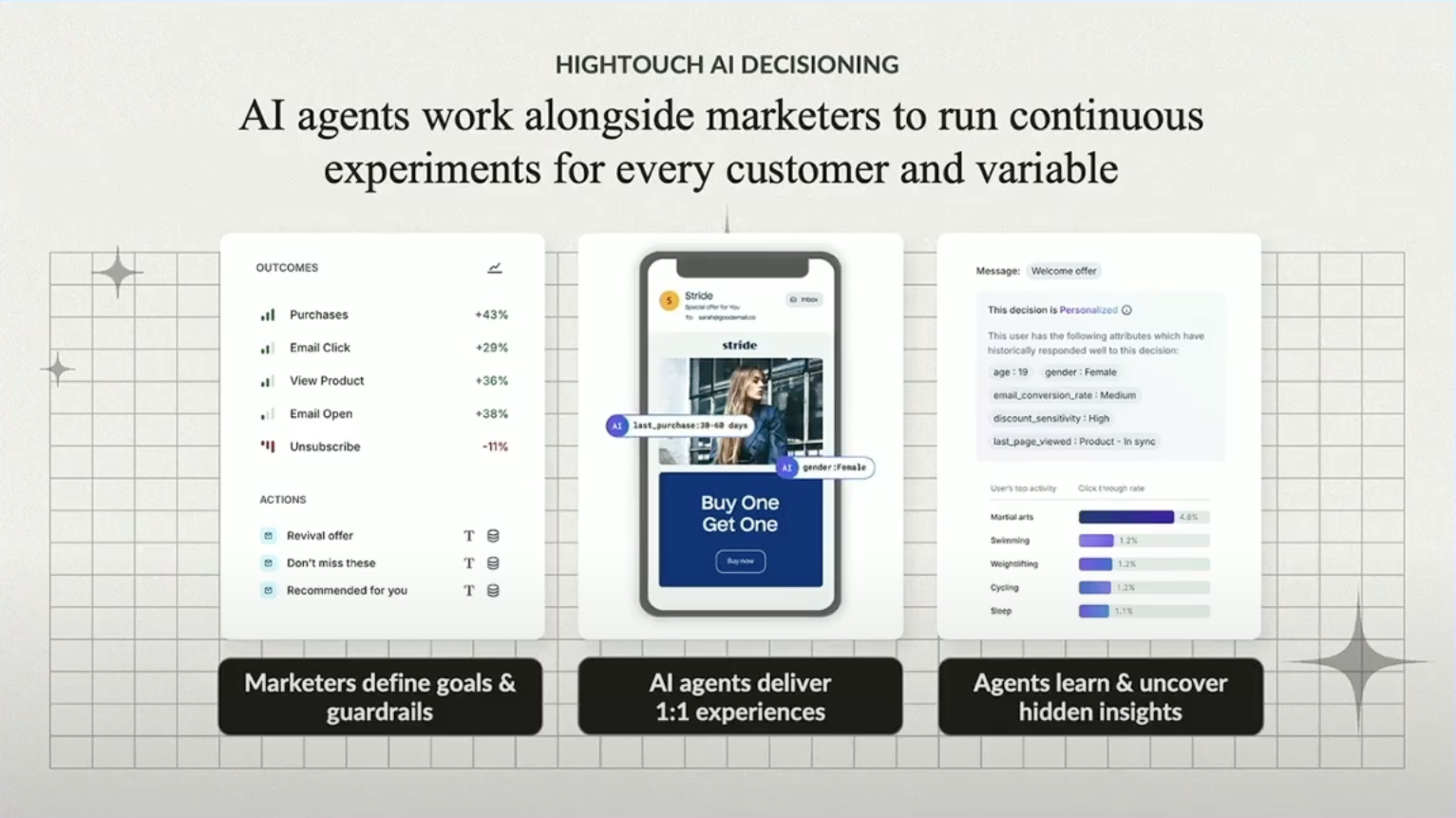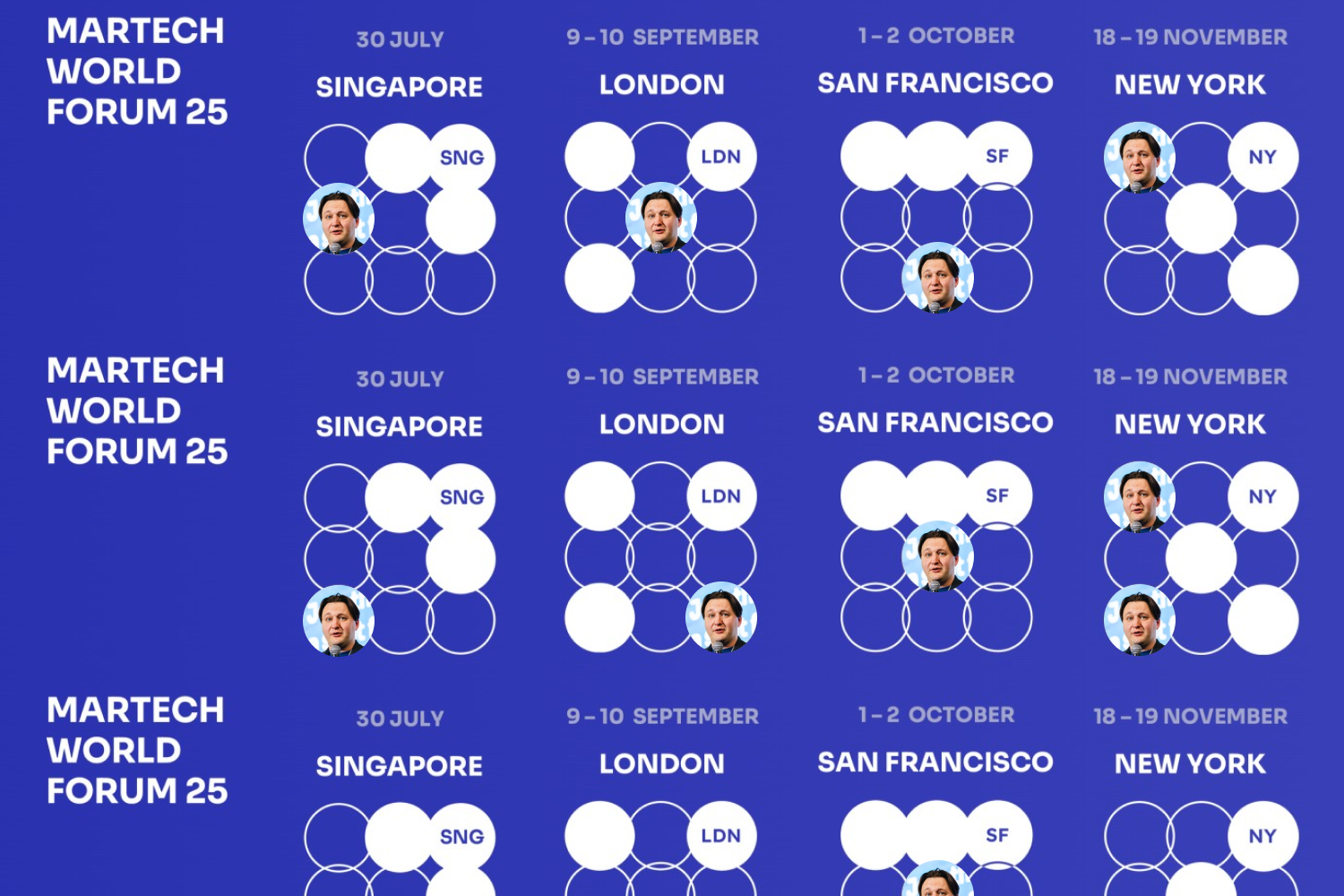AI decisioning: Hightouch on shaping the next era of outcome-based marketing

The genesis of Hightouch: from reverse ETL to composable CDP
Alec, you've had a significant journey in the Martech space, including your time at Red Ventures before Hightouch. Could you share a bit about that background and how it shaped your perspective on the challenges Hightouch aims to solve?
Absolutely. I was Director of Data Products and Martech at Red Ventures in Charlotte, North Carolina. My role involved building the infrastructure and Martech stack—everything from CDPs to ESPs. When I started, Red Ventures had 13 different email platforms across more than 30 businesses. It was very much a deep dive into Martech—rolling out tech like ESPs, CDPs, you name it.
For context, Red Ventures owns brands like Bankrate, Healthline, The Points Guy, and CreditCards.com across various verticals. We had a ton of different marketing technologies across these businesses and even built our own CDP at one point. Over my time at RV, I ran quite a few martech evaluations, and let’s just say I came away with many lessons from them.
Eventually, we adopted Hightouch. I rolled it out over two years, and then joined the company. When I came over, I was the first product marketing hire, focused on helping marketers understand Reverse ETL and the concept of a Composable CDP. Today, I’m the GM of our AI Decisioning product. So, my background is squarely rooted in Martech, from the ground up as a practitioner.
How has the company approached educating marketers and convincing them to embrace new paradigms, like with Reverse ETL and Composable CDP?
We’ve always been about martech category creation. With each big wave (Reverse ETL, Composable CDP, and now AI Decisioning) we’ve found ourselves where the puck is heading, so to speak. The hardest part of that, however, is educating the market: showing marketers this is a new approach worth embracing. Each time, we knew we had the right product for the moment. It was just about helping people understand it and trust what we’ve built to embrace it.
Could you delve into the core problem Reverse ETL aimed to solve? What was the key insight about the data warehouse’s evolving role that spurred its development?
Reverse ETL came from the realization that the data warehouse was becoming the most important data store at companies. With Snowflake, Databricks, and the rise of lakehouses, it became easier and safer to centralize data. However, the warehouse was still mostly seen as a place for analytics.
We flipped that: what if the warehouse could power action and drive real revenue? Reverse ETL was about making warehouse data usable across marketing and business tools. It let data teams sync trusted data directly into those tools, turning the warehouse into an operational system and not just a reporting layer.
Following Reverse ETL, Hightouch introduced the Composable CDP. How did this concept build upon the foundation of Reverse ETL, and what specific needs or gaps was it designed to address for marketers?
Once we saw that people wanted to activate warehouse data, the next step was giving marketers the tools to do so directly. That meant building the pieces needed to replace a traditional CDP: audience building, identity resolution, governance, and event collection; everything, but this time centered on the warehouse.
That’s what became the Composable CDP which is now the new norm of the entire CDP category. It’s what got us to where we are today. And now we’re evolving it again with AI Decisioning.
Introducing AI Decisioning: The third paradigm of marketing
What were the limitations you observed in traditional marketing campaign management that signaled an opportunity for an AI-driven approach?
With Composable CDP, we saw how much manual effort marketers still put into campaign decisions. Everyone wants 1:1 personalization, but getting there is tough. You’re trying to answer: What content should I send? What’s the right offer? What’s the best time? What’s the right channel? In what order?
You either send batch campaigns on a calendar or build complex trigger-based journeys. Both approaches require a ton of human effort and don’t scale well. Your personalization is limited by how many rules you can write.
We saw an opportunity to change that. What if you let AI agents powered by reinforcement learning make those decisions instead?

How does Hightouch define AI Decisioning, and what fundamental problem is it engineered to solve for marketers grappling with an ever-increasing number of decisions?
We’ve built a decisioning layer that sits on your data warehouse. It’s part of the Hightouch platform and is truly composable. This means you don’t need our specific CDP capabilities to use AI Decisioning. It can plug into your data warehouse, connect to your existing Martech stack, and critically, it doesn’t store your data. It gives marketers the ability to build AI agents where they start by defining an outcome.
It’s a shift in thinking. The system isn’t looking at audiences in the traditional sense or predefined journeys. Instead, it’s saying, “Here are all the potential actions or messages I could pick from. Here’s the rich context on an individual user, like Alec, which is all the data already in your data warehouse.” Then it uses reinforcement learning to figure out what specific experience Alec needs to guide him towards that desired outcome. It’s about moving from broad segments to individual-level decision-making, powered by the data you already own.
You refer to AI Decisioning as "outcome-based marketing" and draw parallels to AdTech platforms like Performance Max. Can you elaborate on this concept ?
It’s a new way to think about marketing. I like to talk about outcome-based marketing, where you start with the goal. You define what you want to achieve, and then you allow the system to pick the best path for each individual. This is the same concept that has already happened in AdTech. Think about Performance Max on Google or similar capabilities on Facebook; it has been around for many years. It used to be that you had to go in and build every single individual ad unit and campaign structure on Facebook and Google. Now you don’t. Now you just define your rule, give it the content, set your guardrails, and it goes. It’s the same fundamental idea.
The difference, and it’s a crucial one, is that with our system, because it’s operating on your own channels, it’s on your data. So, you have full control over what the AI is learning from: what content it has access to, what channels it can utilize. Also, it’s exposing all those insights back to you. The system helps you understand, “Why did we pick this specific message for Alec?” “Why did we choose this time of day? Because Alec has these particular attributes.” It’s exposing deep insights and trends.
This is a stark contrast to platforms like Google and Facebook, where it often feels like a black box; you just don’t know why certain decisions are made. What’s really cool is as our system experiments and learns, it’s showing you all the insights. This allows you to understand and, more importantly, better trust the system.
Obviously, letting AI take the reins is a scary concept for many marketing teams. They worry about it taking over. But if they can trust the system, see what’s happening from an observability perspective, and learn alongside it, they can better trust what’s actually happening and feel more comfortable.
This is the third paradigm of marketing: the first was batch and blast, the second was trigger journeys, and now we’ve entered the era of outcome-based marketing as the third paradigm.
AI Decisioning in action: Powering outcome-based marketing and ensuring trust
Can you walk us through a practical example of AI Decisioning? How do they define an outcome, and how does the system then work to achieve it?
Petsmart is one of our bigger customers using AI Decisioning. They’re a large pet retailer in the US with 70 million loyalty customers. A key goal for them was to drive cross-sell purchases into grooming appointments. They wanted someone to actually come in and get their dog groomed, which is a highly sticky conversion event and very profitable for them. Previously, they were doing this with calendar-based sends, sending many different emails and building numerous rules; they felt AI could figure this out more effectively.
Now, they go into Hightouch and set their desired outcome as the ‘appointment booked’. They give the system access to all their different assets inside of Salesforce Marketing Cloud – the different content pieces, templates, channels, subject lines, all those things. They set guardrails around these assets, and then AI Decisioning figures out what to send each individual user. As it does this, it experiments within their defined guardrails and tries to understand, “Okay, Alec has these attributes. What is the best experience that Alec needs to get him to that desired outcome of booking a grooming appointment?” It’s no longer about static audiences or predefined journeys; it’s about dynamically selecting from all available options based on the individual’s context and the desired goal.
How does the AI actually determine what content or channel is best for an individual like "Alec"? What data does it learn from, and can it start from a "cold start" if needed?
The system uses reinforcement learning, considering all the rich data on “Alec” available in the data warehouse. This includes his attributes and past behaviors. It can cold start if you truly wanted to begin from zero, where it has no context about historical campaigns or user attributes. In such cases, you can set the threshold for explore versus exploit, working with our team to ensure that it’s a good balance.
However, we recommend giving the system access to your historical data that’s already in your data warehouse. For instance, if we know a type of content has been sent in the past, or a specific subject line works best, or a certain day of the week is optimal, the system doesn’t need to start from that cold start problem when you’re first launching the agent. One important callout is that these agents don’t learn across different brands; the learning is specific to your data and your company. So, if you have historical data, we can read from it. If not, it can certainly cold start and will then explore and exploit. We’ve also built advanced capabilities from a modeling perspective, what we call ‘intelligent targeting,’ where you can throttle up or down to focus on users with the highest predicted uplift, rather than spending time on users unlikely to be impacted by marketing.
What kinds of insights can marketers expect to see about the AI's actions and the "why" behind them?
Observability was one of the two fundamental things we needed to get right from day one, the other being governance. Understanding what’s going on, understanding performance, and finding insights are key. There are different layers to insights. First, there’s “What’s happening and why?” You want to know what the agent is even picking and why it sent a particular message to Alec. You can see this in our inspector tool: “Yesterday, it sent out this to this person. Here’s why it made these decisions.” Or, “Tomorrow it’s going to send out this because of these decisions.” This is more of a manual way to get a read on it, not quite a formal report.
Then there’s performance. In the system, you can set a hold-out group so you can measure lift. If you create an agent with a 10% holdout, you can measure the lift from the decisions made and the overall lift of running the agent versus the holdout or versus human-based marketing. Often, people will put their teams up against the agents to understand if it’s adding lift.
My favorite part, though (by a mile) is the deep insights it exposes that you otherwise never would have thought to look for. For example, Whoop, a fitness tracking company and another of our customers, their cross-sell agent uncovered that users with a top activity of martial arts respond really well to swimming creative. They dug in and learned it’s because these users want low-impact ways to recover (aka swimming). The system is exposing that back to you. We use things like heat mapping, where you can do cross-analysis. For instance, looking at the email click rate on certain products based on the last product category someone purchased. Or for Fintech, cross-analyzing gender and age group against financial products or CTAs. The system can even use LLMs to tag content, so you can look at dimensions like tone or image type. More and more, we’re excited about automatically surfacing the best trends to you in the UI, so you don’t have to dig.
It quite literally turns your owned channels into an AI learning ground.
You've emphasized the importance of "governance" and "guardrails." What are these in the context of AI Decisioning, and how do they give marketers control, particularly in regulated industries or when dealing with sensitive offers?
Governance, particularly guardrails, is absolutely critical to making sure you have control. Guardrails are important from a couple of perspectives. Let’s say I’m a financial services company building an agent for cross-selling different products. I might have a specific email for loan recommendations, but I don’t want that to go out to anyone whose credit risk is high right now. The agent might find that users click often on loan recommendations when their credit risk is high because they need that financial product, but from a business perspective, I don’t want that.
You should be able to implement a rule stating, “If credit risk is high, don’t even let them be eligible for this.” In our system, there are eligibility rules within each ‘action’ (like the loan recommendations email). You can simply say, “If credit risk is high, don’t allow the agent to choose that message.” There are also guardrails around timelines, which is important for retail companies. For example, a 20% off offer only available in April, or a specific creative for summertime. You can set timelines so the agent can only pick from those within that set guardrail. You’re really controlling what the agent can do and pick from, which makes marketers much more comfortable.
Some brands, like a luxury watch company we’re talking to, don’t want us to ever make personalization decisions within emails themselves; they would rather give the system hardcoded emails and have us simply pick ordering, timing, etc. That’s another way to do it. The system is flexible; you can have it pick from a hundred completely dynamic emails, SMS, and push notifications, or just hardcoded emails, and you’ll still see a lift. You’re also controlling the inputs of what the system’s learning from – the attributes it should use to learn about Alec, like loyalty status, state, age, or propensity scores.
The AI frontier: Strategy, stacks, and insights
Given that AI Decisioning is a new category, what's Hightouch's strategy for educating marketing teams, ensuring they understand the system, and helping them successfully integrate it into their workflows?
It’s important to find the right use cases because this type of system is good in specific environments. There are many cases like win-backs, cross-sells, and these evergreen campaigns where reinforcement learning can thrive. There are some use cases where it simply isn’t as effective, for example, if it doesn’t have enough volume. For instance, Hightouch, in our own B2B environment, has a smaller user base; we don’t have enough actions for the system to learn from. Knowing what companies this works for and what use cases it’s really good at powering is an important first step. We’re always very specific in our content about these evergreen campaigns.
Also, making sure marketers understand what this shift actually looks like is key. They are now thinking about creative, guiding the system, learning from it, and then giving it better creative so it can operate and fly. Much of it is enablement and teaching them about this new category and this new shift, more so than any type of technical implementation. The technical implementation is actually not difficult, especially if they’re already a Hightouch customer, as we know they’re on the data warehouse and we’re already integrated with their downstream platforms. Building the agents isn’t hard; it’s teaching them how to think about using them.
Our team helps a lot with this education. The funding we raised has allowed us to hire an entire team of machine learning engineers who work behind the scenes with customers. They help them understand the best use cases, how to think about assets and tagging, and then actually toggle things behind the scenes if needed. While this is a fully self-serve product, we want marketers to feel in full control, and our team is there to help guide them. Helping them understand they can trust the system is really important. When we stand up the first use case, there’s often a recurring check-in where we’ll go through the insights for them. It’s very much a partnership to help them get over that hump, and then once they are, they just fly. This is just a challenge with category creation; you’re entering a space where people just aren’t used to this.
You've touched on the complexities of bringing such an advanced product to market. What are some of the key challenges in explaining the depth of AI Decisioning's capabilities while ensuring marketers feel it's built for them and not overly technical?
We truly have a best-in-class machine learning product behind the scenes. The algorithms we have, the bandits that are running—my mind is blown every day at what our team is pushing out and the advancements they’re making. The hard part is that, because we’re going for this self-serve model where marketers feel like they can run this thing and we build the best-in-class UI, it’s quite tricky from a go-to-market perspective to explain the depth of this system while still making sure that marketers feel like it’s for them.
We’ve been focusing on the latter, making it accessible, rather than always leading with the deep technical capabilities. There are others in the space that lean into a less self-serve, more custom solutions model, pushing their ML capabilities. We’re trying to bring those best-in-class capabilities to the marketer and help them feel like they have this in a UI that makes sense to them. If you tried to say, “complex, gradient-boosted CMABs” to a marketer, most of the time they’re going to look at you and wonder what that means. Especially now, where we’re in this category creation mode, bringing a net new capability out there. It’s a balancing act: how do you explain the depth and power of this thing while still making it known that this is built for marketers? The marketing itself might not do it full justice yet because of how early on the overall space is.
There are other players emerging in the AI marketing space. What key architectural and philosophical decisions do you believe differentiate Hightouch's AI Decisioning product and make it uniquely suited for marketers?
A couple of things. One, we are built from day one for the marketer, with governance and observability built-in. There is a self-serve UI that you can use. We really lean into the self-serve UI, letting marketers be in control of this and trust the system. We are built for the marketer with the best-in-class ML capabilities that the data teams want.
Second, we’ve been built on the data warehouse from day one and do not store your data. Other platforms out there require you to upload data to them, upload your content to them, and then pass decisions back, either in files or sometimes now engaging in downstream platforms. For us, it’s: “No, it’s your data. We’ll bring you the ML, we’ll learn from it, and we don’t want to store any of it. Don’t create any data redundancy in your tech stack and read from the best store of data, which is your data warehouse.” For example, one of our customers had a propensity score created in their data warehouse that they wanted to use as an attribute for the agent. In Hightouch, it’s just one click to add the attribute, versus having to upload that to another system and wait for it to learn. If it’s available in the warehouse, it’s there; go. This allows your data team to get decisions back into the warehouse and your data science team to think about what models to create to feed the system.
The last one is that we are a decision layer above your channels. This is a bit understated today. When you think about just email, I understand why someone would ask why this isn’t just in their ESP. One, we have access to all your data and can read from it. But two, when you start to think about how this grows across channels – to on-site, to in-app, to custom in-house solutions – the fact that it’s a decision layer above is key from an architecture perspective. I just know that we’re in the best position possible
To wrap up, what books or podcasts are currently capturing your attention, especially around AI or broader themes? And perhaps a fun one, what's your favorite app on your phone right now?
We’re doing an AI book club with some friends, currently focused on the “AI in 2027” article. It’s not really a book, but we’re diving in and analyzing it. I think it goes to extremes, but it’s very thought-provoking about how AI really is going to change our world. I also helped write a book called “Adapt or Die,” which Scott Brinker is also part of, so I suppose I should read the whole thing soon!
For podcasts, I love “The AI Daily Briefing,” formerly “The AI Breakdown”. I listen to it in the gym every morning; it’s about 10 minutes, fast-paced, and keeps me up to date. There was one the other day about how AI changes agencies and how the one-man agency might be paid based on outcomes, which was really interesting.
As for my favorite app, I’ve been very deep in Reddit threads lately. I generally like Reddit a lot; it’s so raw. It used to be Twitter, but since it changed to X, I think the quality has gone down a lot. So, I’m a big Reddit fan in the right communities; I think it’s really powerful. I also use ChatGPT constantly in my daily life- it recently planned an entire two-week Europe trip for me!

Lauren Stein, chief of staff, on orchestrating GrowthLoop’s Compound Marketing revolution
How GrowthLoop is redefining martech by embedding AI agents directly into the data cloud for compounding strategic returns.